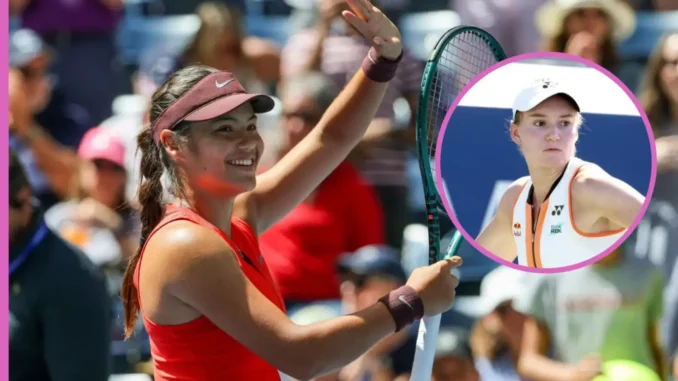
The 2025 US Open has delivered electrifying tennis, and the third-round showdown between Emma Raducanu and Elena Rybakina, set for August 29 on Louis Armstrong Stadium, promises to be a blockbuster. Raducanu, the 2021 US Open champion, faces her toughest test yet against the No. 9 seed and 2022 Wimbledon champion Rybakina. This clash pits Raducanu’s revitalized form and tactical acumen against Rybakina’s formidable power game, setting the stage for a battle of contrasting styles. With Raducanu’s resurgence and Rybakina’s relentless baseline dominance, the match hinges on key tactical elements that could define who advances to the fourth round.
Raducanu, now ranked No. 36, has been a revelation at Flushing Meadows, dispatching qualifiers Ena Shibahara and Janice Tjen in a combined two hours and two minutes, dropping just six games across four sets. Her serve, refined under new coach Francisco Roig, has become a cornerstone of her game. Against Tjen, she landed 79% of her first serves, firing eight aces and winning 76% of first-serve points. “I thought that I served very well, and yeah, I put quite a few aces on the board today,” Raducanu remarked, underscoring the weapon her serve has become. This precision allows her to dictate points early, stepping inside the baseline to unleash aggressive groundstrokes. Her ability to take the ball early and redirect pace could disrupt Rybakina’s rhythm, but she’ll need to maintain this level against a top-10 opponent. Raducanu’s tactical approach will likely focus on varying spin and pace, using her court craft to draw Rybakina into extended rallies where her movement and anticipation shine.
Rybakina, a powerhouse with nine WTA titles, including recent triumphs in Strasbourg and Cincinnati, brings a different challenge. Her serve, one of the tour’s most dominant, has produced 363 aces in 2025 against 165 double faults, with a 73.7% first-serve point win rate. Her second-round win over Tereza Valentova (6-3, 7-6) showcased her ability to save set points and close tight matches, though her 53% first-serve percentage and 44% second-serve points won reveal vulnerabilities. “She’s been at the top of the game for so long and very dominant and has big weapons, has a huge serve and big groundstrokes,” Raducanu said of Rybakina, acknowledging the challenge. Rybakina’s strategy will lean on her thumping groundstrokes to push Raducanu deep, aiming to overpower her from the baseline and limit her counterpunching opportunities.
The tactical battle hinges on serve and return dynamics. Raducanu’s improved serve gives her a chance to hold comfortably, but she must attack Rybakina’s second serve, where the Kazakh’s win percentage dips. Rybakina, conversely, will target Raducanu’s second serve, historically a weak point, though recent improvements under Roig have bolstered its potency. Raducanu’s ability to mix slice and topspin, reminiscent of Ashleigh Barty’s versatile game, could unsettle Rybakina, who thrives on consistent pace. “I do want to see how my game suits and fits against the top,” Raducanu noted, eager to test herself. Her recent matches against world No. 1 Aryna Sabalenka, including a tight Cincinnati loss, suggest she can hang with elite players, but Rybakina’s straight-sets win over Sabalenka in Cincinnati underscores her danger.
Their lone prior meeting, a 6-0, 6-1 Rybakina rout in Sydney 2022, is a distant memory given Raducanu’s growth and Rybakina’s evolution. Their recent doubles partnership in Washington, where they reached the semi-finals, adds intrigue, with Raducanu noting, “She’s obviously got an amazing serve so that helps a lot on the doubles court and on the singles court, too.” Rybakina, respectful of Raducanu’s form, said, “She’s a tough competitor. She’s been playing really well lately.” The Louis Armstrong crowd, which Raducanu has energized with her fearless play, could tilt momentum if she starts fast. Tim Henman, analyzing her form, observed, “She’s making those incremental improvements all the time,” suggesting her early ball-taking and speed could challenge Rybakina’s power.
For Raducanu to win, she must disrupt Rybakina’s serving rhythm and avoid being pinned back by her groundstrokes. Rybakina, favored with a 61% win probability per predictive models, will aim to dominate with first-strike tennis. The match could go three sets if Raducanu leverages her variety and movement, but Rybakina’s experience in big matches gives her an edge. As Raducanu embraces the pressure—“I’m embracing the pressure and expectation a lot more now”—this clash will test her readiness to reclaim her 2021 magic against one of the WTA’s most formidable forces.
Leave a Reply